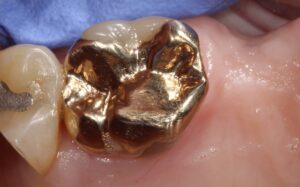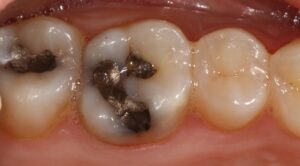This is certainly an “electrifying” topic (pun intended). After all, learning that electric current can run through your own body can be quite a “shock” to almost anyone!
In dental galvanism, a small amount of electricity is generated when two dissimilar metals in dental restorations make contact, most often when teeth with those metals touch. The result is a harmless but very memorable shock!
There’s Gold in Them Thar Hills
Many years ago, dental gold was the most commonly used material in crowns. In fact, a gold crown was considered the “gold standard” in reliability, especially for back teeth.

Gold onlay on a molar tooth. If this contacts an amalgam filling on another tooth, be prepared for a small but real shock!
Dental gold is actually an alloy of many metals. But the biggest component is gold. While gold crowns are not used very frequently anymore, there are still hundreds of thousands – if not a couple of million – Americans with gold in their mouths.
An Amalgamation of Metals
Dental amalgam is a filling material that is still used today. True to its name, it is an amalgam or mixture of many metals. Those metals include silver, mercury, tin, copper, and other elements in trace amounts.

Mercury/Silver amalgam fillings on two back teeth. If there’s a gold crown on a tooth below these, look out!
Amalgam is mixed and then placed directly into the the tooth where it will then harden up. With time, the surface will tarnish a bit, but the metal is still exposed and can participate in galvanic shock.
“Current” Explanation on Galvanism
We’ve established that in certain people, there can be two different or dissimilar metals in your mouth. Those metals are bathed in saliva with ions which acts as an ideal conductor of electricity. So what causes the shock?

A silver fork can also produce galvanism.
Certain metals can have what are called electrical potentials. This means that there is the possibility for electrical current to flow to or from that metal. Current can flow if that metal is connected to another, different metal if there is a difference in potential. For example, if a gold crown makes contact with an amalgam filling, current can flow between them because there is a difference in electrical potential between the gold in the gold crown and certain metals in the amalgam filling.
Examples where galvanic shock can occur include:
- A gold crown contacting an amalgam filling.
- The tine of a silver fork or other utensil contacting a gold crown.
- A piece of aluminum foil touching a gold crown or amalgam filling.
When this occurs, a noticeable and memorable shock will occur. If you are not expecting it, you will be very surprised!
How to Treat Dental Galvanism
If this does occur to you, there are different ways to approach it. The easiest way is for your dentist to adjust the filling and/or gold crown so that they can’t touch one another when you chew. If one or both metals become tarnished, the galvanic shock will not occur, but there is no good way to produce a tarnish over the restorations. In more extreme cases, the fillings or crowns can be replaced.
Generally speaking, we don’t recommend treating it, unless the shocks are so frequent and annoying that you are unable to chew normally. Please see the disclaimer below:
Note: there are many websites and even dentists who claim that dental galvanism can lead to many systemic diseases and other conditions. Proceed with caution should you elect to believe these sources. We will never propose treatment of dental galvanism for any of our patients unless YOU want us to!
